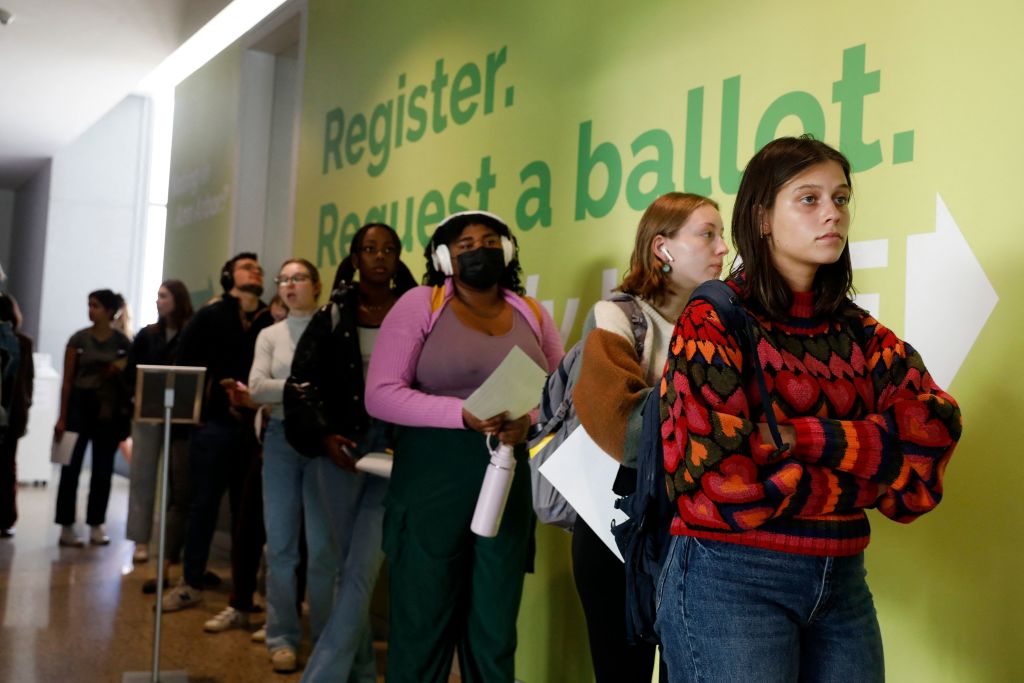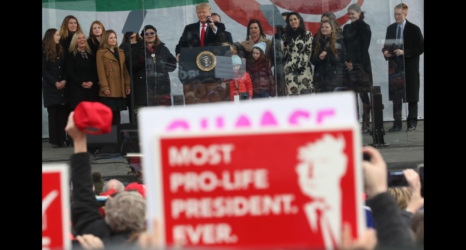
At 18, Americans can purchase a firearm, enlist in the military, or be forced to carry an unwanted pregnancy to term. But Republicans are increasingly eyeing raising the minimum voting age to at least 21.
Republicans have reason to be scared: Last year’s midterm elections had the second-highest youth voter turnout in 30 years, according to the Center for Information and Research on Civic Learning and Engagement at Tufts University. This gave Democrats the largest margin ever among young voters—especially young women and youth of color—allowing Democrats to flip and keep seats and protect abortion rights in six states.
- In Arizona’s governor’s race, young people supported Democrat Katie Hobbs three times the winning margin of victory. With just under 20,000 votes, Hobbs’ win flipped the state for Democrats. (Just weeks before Arizona’s midterm, Hobbs reported six accounts of voter intimidation and election worker harassment to law enforcement. “No voter should feel threatened or intimidated when trying to vote,” she said. “Anyone attempting to interfere with that right should be reported.”)
- In the nail-biting Pennsylvania Senate race, Democrat Lieutenant Governor John Fetterman narrowly beat Republican candidate, Dr. Mehmet Oz, by 2.5 points. Oz believed abortion should be decided by politicians like him and young voters, who are more likely to support abortion rights than older people, responded—backing Fetterman 70 percent to 28 percent.
- Young voters were also pivotal in Wisconsin—supporting Democratic Governor Tony Evers 70 percent to 30 percent over Republican opponent Tim Michels and securing the governor’s house in this swing state. Despite this win, Wisconsin Republicans have imposed harsh restrictions on using student IDs for voting. The state requires poll workers to check signatures only on student IDs, but some schools issuing IDs that serve as debit cards and dorm room keys have removed signatures. Wisconsin Republicans have considered this a security risk, which is why the law requires that IDs used for voting expire within two years.
- In Nevada, young voters preferred Democratic incumbent Catherine Cortez-Masto, propelling her to victory by just 8,000 votes. Young people helped her secure Senate control for the Democrats.
This year marks the 52nd anniversary of the ratification of the 26th Amendment, which lowered the voting age from 21 to 18. But youth voters still face many roadblocks: The Voting Rights Alliance has documented over 61 forms of voter suppression in the U.S., many of which affect young people, such as the refusal to place polling sites on college campuses, strict voter ID laws and student voter restrictions, long lines, and racial gerrymandering.
“Gen Z voters should take voter suppression threats extremely seriously,” said Loretta Ross, co-founder of SisterSong, Smith College professor and MacArthur fellow. “The Gen Z voters that [Republicans] are scared of are their own children, are their neighbors’ children. They can’t hide in their gated communities from their own children.”
“And it’s not only the youth vote,” added Ross. “[Republicans] are afraid of the women’s vote as well.”
Youth Voters Helped Fight Off a ‘Red Wave’
“Gen Z is quickly becoming one of the Democratic party’s most reliable constituencies,” tweeted the first Gen Z member of Congress, Rep. Maxwell Alejandro Frost (D-Fla.), after the midterms. “Year-round organizing with young people and not being afraid to talk about the bold change we need will keep this trend moving in the right direction.”
While Gen Z helped to hold off the predicted “Red Wave,” their votes varied widely by gender, race, ethnicity and sexual orientation.
- Young women voted for Democratic House candidates at higher rates than men—71 percent to 53 percent.
- Youth of color supported Democrats by even larger margins. Eighty-seven percent of Black youth and 67 percent of Latino youth voted for a Democratic candidate—compared to 57 percent of young white voters. Young women of color were even more likely to vote for a Democratic candidate.
- LGBTQ youth made up 21 percent of all young voters and showed the largest vote choice gap of any other group of young voters: 93 percent for Democrats and 5 percent for Republicans.
Georgia was ranked the #1 Senate race in the country where young voters could influence the results. Young voters preferred incumbent Sen. Raphael Warnock (D) over Republican challenger Herschel Walker 63 percent to 36 percent before the Dec. 6 runoff.
Months before the midterms, the ACLU of Georgia warned that Fulton County (home to Atlanta) would not be providing early voting on any college or university campus in the county—limiting ballot access for Georgia’s most diverse universities, such as Georgia State University, which serves more than 30,000 students and has the highest number of Black graduates in the country.
Loretta Ross described her experience early voting for the Senate runoff in Atlanta: Since officials reduced the number of polling sites from about 30 to 10, voters from different neighborhoods had to wait hours in line at a limited number of polling sites.
Ross said two-thirds of her long line included young people. “It felt encouraging looking at the multiracial nature of the people determined to vote and standing in line. I got a feeling that not a whole lot of Republicans came over to the Black side of town because they’re too afraid of us.”
In the end, voters under 30 cast 25 percent of the votes received in the Dec. 6 Georgia runoff, according to the secretary of state’s office.
“Students are always the tip of change in our country,” said Warnock. “Not much happens in the way of transformation and meaningful change without the voices of young people.”
The Power of Same-Day Voter Registration
Same-day voting—policies that allow eligible voters to register and cast a ballot simultaneously—has been shown to increase the turnout of young people by 3.1 to 7.3 percentage points, an effect even more pronounced in presidential elections.
Currently, 22 states and D.C. allow same-day registration:
- California
- Colorado
- Connecticut
- Hawaii
- Idaho
- Illinois
- Iowa
- Maine
- Maryland
- Michigan
- Minnesota
- Montana
- Nevada
- New Hampshire
- New Mexico
- North Carolina
- Utah
- Vermont
- Virginia
- Washington
- Wisconsin
- Wyoming
Youth Voter Suppression
The right-wing has had its eyes on raising the voting age and hindering young voters well before the November elections. Aside from closing college polling sites, some states limit voting eligibility for out-of-state students.
- In New Hampshire, a Republican-backed law took effect in 2019 requiring newly registered voters who drive to establish a “domicile” in the state by owning New Hampshire driver’s licenses and auto registrations—which costs hundreds of dollars annually.
- In Florida, the Republican secretary of state outlawed early-voting sites at state universities in 2014. However, a federal court overturned the ban, which drew in 60,000 votes cast on campus in 2018. In 2019, the state legislature reinstated the ban.
- North Carolina Republicans enacted a voter ID law in 2018 that recognized student identification cards as valid—but its requirements proved unmanageable and major state universities were unable to comply. A later revision relaxed the rules, but a lot of confusion remains and fewer than half the state’s accredited schools have sought to certify their IDs for voting.
- In Tennessee, voter ID laws do not recognize student ID cards as valid for voting and legislators removed out-of-state driver’s licenses from the list of valid identifications.
- In Texas, educators are required to distribute voter registration forms to high school students, but most of the state’s secondary schools seem to ignore this requirement. The state also bars students from registering until two months before their 18th birthday. The state’s voter ID law still excludes college and university ID cards and only allows out-of-state driver’s licenses.
Nationwide, college students are concerned about threats to their voting rights.
“The fact that there are Republicans calling to raise the voting age to 21 because Gen Z showed up in HEAVY Democratic numbers last night is both laughable and terrifying,” tweeted Olivia Julianna from Gen Z for Change, a nonprofit leveraging social media to promote civil discourse and political action.
“This is a deliberate effort to exclude young voters, who often vote blue,” said Hannah Phelps, a 21-year-old college student from Connecticut.
“[Republicans] are aware of how much power the young people in our country hold,” said Aimee Dupont, 22, from Massachusetts. “This is an attempt to take away Gen Z’s voice.”
Young voters were the only age group to cite abortion as their top priority in exit polling. (Among all women voters, abortion and women’s rights were tied with inflation and rising prices in determining their votes, according to a Ms. poll ahead of the midterms.) But young voters have multiple priorities, including inflation, climate justice, gun control and immigration.
Young people will soon dominate the electorate, which means Democrats and Republicans must center their future campaigns on their issues. “Everything hinges on voting rights,” said Ross.
Up next:
U.S. democracy is at a dangerous inflection point—from the demise of abortion rights, to a lack of pay equity and parental leave, to skyrocketing maternal mortality, and attacks on trans health. Left unchecked, these crises will lead to wider gaps in political participation and representation. For 50 years, Ms. has been forging feminist journalism—reporting, rebelling and truth-telling from the front-lines, championing the Equal Rights Amendment, and centering the stories of those most impacted. With all that’s at stake for equality, we are redoubling our commitment for the next 50 years. In turn, we need your help, Support Ms. today with a donation—any amount that is meaningful to you. For as little as $5 each month, you’ll receive the print magazine along with our e-newsletters, action alerts, and invitations to Ms. Studios events and podcasts. We are grateful for your loyalty and ferocity.





